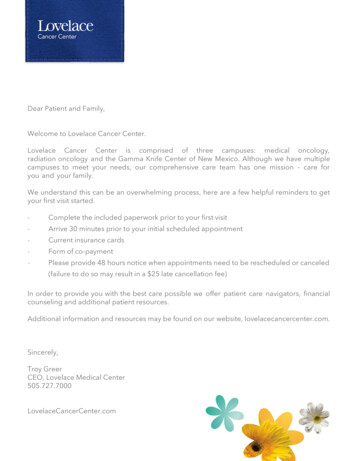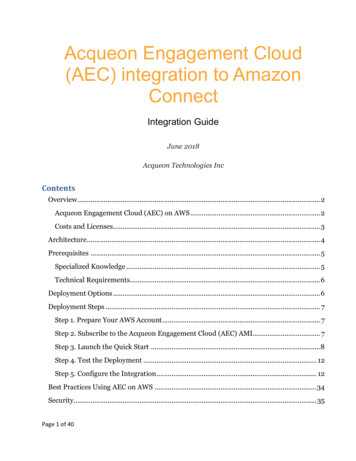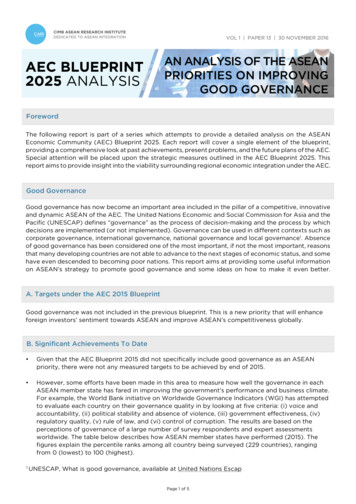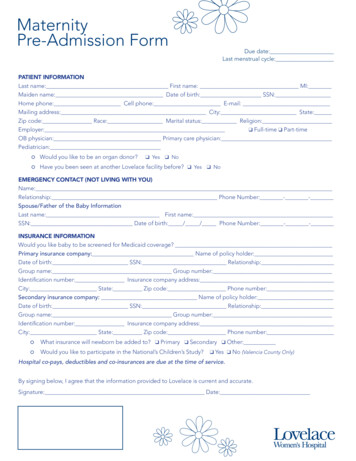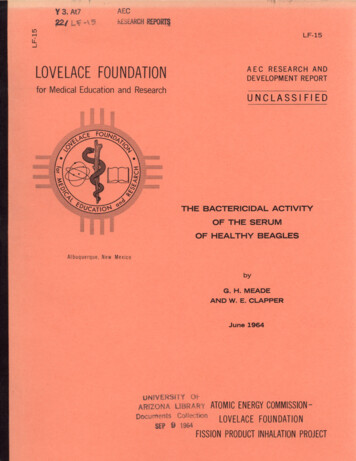
Transcription
Y 3. At?AECRESEARCH REPORT inLF-15iHLLAEC RESEARCH ANDDEVELOPMENT REPORTLOVELACE FOUNDATIONfor Medical Education and ResearchUNCLASSIFIEDTHE BACTERICIDAL ACTIVITYOF THE SERUMOF HEALTHY BEAGLESAlbuquerque, New MexicobyG. H. MEADEAND W. E. CLAPPERJune 1964UNIVERSITY OhARIZONA LIBRARY ATOMIC ENERGY COMMISSION Documents CollectionSEP 9 1964LOVELACE FOUNDATIONFISSION PRODUCT INHALATION PROJECT
LEGAL NOTICEThis report was prepared as an account of Government sponsored work.Neither the United States, nor the Commission, nor any person actingon behalf of the Commission:A.B.Makes any warranty or representation, express, or implied,with respect to the accuracy, completeness, or usefulness ofthe information contained in this report, or that the use of anyinformation, apparatus, method, or process disclosed in thisreport may not infringe privately owned rights; orAssumes any liabilities with respect to the use of, or fordamages resulting from the use of any information, apparatus method, or process disclosed in this report.As used in the above, "person acting on behalf of the Commission" includes any employee or contractor of the Commission to the extent thatsuch employee or contractor prepares, handles or distributes, or provides access to, any information pursuant to his employment or contract with the Commission.Printed in USA. Price 0.50. Available from the Office ofTechnical Services, Depa rtment of Commerce,Washington 25, D.C.
UNCLASSIFIEDLF-15Biology fc MedicineTID-4500 (31st Ed. )THE BACTERICIDAL ACTIVITY OF THE SERUM OF HEALTHYBEAGLESbyG. H. Meade and W. E. ClapperSubmitted as aTechnical Progress ReporttoThe Division of Biology and MedicineUnited States Atomic Energy CommissiononContract No. AT(29-2)-1013June, 1964From the Department of MicrobiologyLovelace Foundation for Medical Education and ResearchAlbuquerque, New MexicoUNCLASSIFIED
ABSTRACTA relatively simple method for testing the bactericidal activity ofserum from beagles which gave reproducible results was found. Activitywas measurable for a strain of Escherichia coli, but not for Pseudomonas aeruginosa, Proteus mirabilis, or Bacillus subtilis.The E . colibactericidin was inactivated by heat, was not restored by the addition ofguinea pig complement, nor augmented by adding complement to the unheated serum.Such serum activity is apparently part of the immunemechanism of beagles and may be important in relation to their abilityto resist invasion of the blood stream by intestinal bacteria.
ACKNOWLEDGEMENTSThe authors wish to express their gratitude to Dr. Clayton S. Whitefor his useful suggestions in the preparation of the manuscript and to themembers of the Department of Veterinary Medicine for obtaining thespecimens from the dogs.11
TABLE OF ods .2List of TablesIntroduction1.Organisms .22.Serum.23.Test .24.Other Methods .3.31.Ps. aeruginosa, Pr. mirabilis, B. subtilis.32.E. coli.5Bactericidal Activity .5Destruction by Heat5Results.Effect of Adding Complement3.Comparison to Other Antibacterial Factors7.7.9References .10Summary111
LIST OF TABLESPageTable 1.Absence of Bactericidal Activity of Serumfrom Beagles for Pseudomonas, Proteus,and Bacillus SpeciesTable 2.Bactericidal Activity of Serum from Beaglesfor E. coli and the Effect of Heat .Table 3.46Effect of Complement on the BactericidalActivity of Serum from Beagles Toward E. coli .IV8
THE BACTERICIDAL ACTIVITY OF THE SERUMOF HEALTHY BEAGLESbyG. H. Meade and W. E. ClapperINTRODUCTIONThe normal bactericidal activity of rabbit serum against Bacillussubtilis was reported by Marcus and Donaldsoning irradiation.to be decreased followThe decrease was greatest during the period when theanimals were more susceptible to infection.Irradiation has also beenshown to decrease the serum bactericidins in mice, rabbits, and guineapigs to a strain of Escherichia coli .These investigators did not feelthat the decrease was related to the post-irradiation bacteremia in mice.Animal species differ in the activity of their serum to different bacteria.3Tilden found that dog serum was bactericidal only to Proteus morganii,Proteus X19, and Sarcina lutea when a large variety of bacteria, including E . coli, were tested. Mackie and Finkelstein reported on theserum bactericidins against Gram positive and Gram negative bacteriain various animals.The literature on this subject has been reviewed bySkarnes and Watson .As a part of a program to study the biological effects in beagles ofinhalation of fission products, observation of any changes in theirimmune mechanisms seemed necessary.serum is one of these.The bactericidal activity of theThis investigation was, therefore, undertaken todetermine what bacterium could be used as a test organism for the factorin the beagle and what method would be most useful for processing arelatively large number of specimens quickly.measure the serum activity, the bacteria tested,properties of the bactericidin are described.The methods used toand some ofthe
METHODS1.OrganismsA strain each of Pseudomonas aeruginosa, Proteus mirabilis, Bacillus subtilis, and Escherichia coli (ATCC 4157) were used as the testorganisms.After growth in 10 ml of dextrose broth (Difco) for 24 hoursat 37 C, the cultures were centrifuged, the broth poured off, and thebacteria suspended in distilled water to a density which gave a reading of150 on the Klett colorimeter using a blue filter.Further dilutions weremade, as found by previous trials with each bacterium, to make an easilydetermined colony count by the method described below.2.SerumBlood from healthy beagles was obtained from the Project colony.The serum,separated after the blood had clotted, was either used immediately or stored at 4 C for no longer than 24 hours,3.TestThe procedure was essentially that described by Pindak with minormodifications.Five-tenths ml of serum, 0. 16 ml of bacterial suspension, andO. 32ml of Kolmer's saline were mixed in a small screw-cappedtube.From this tube duplicate 0. 1-ml samples were immediately removed and spread evenly with a bent glass rod over the surface of desoxycholate or blood agar plates,depending upon the type of bacteriaused. Further dilutions of 1-10 and 1-100 were made in saline and platedin a similar manner.The original undiluted bacterial suspension withserum was then incubated in a 37 C water bath for six hours and 0. 1 mlof undiluted and 1-10 and 1-100 dilutions were again plated.The 6-hourincubation period had been determined by preliminary tests to be themost satisfactory.All plates were incubated overnight at 37 C, afterwhich colonies were counted.The activity after heating the serum to 56 C for 30 minutes andafter the addition of guinea pig complement was determined by the methoddescribed above, except that the amount of serum was reduced to 0. 25ml,
the 10"bacterial suspension to 0. 08 ml, and 0. 16 ml of commercialguinea pig complement replaced the saline used in other experiments.Both heated and unheated complement were added.4.Other Methods(1)The turbidity of a broth suspension of E. coli and a measuredamount of undiluted serum was determined at intervalswithaKlettcolorimeter.(2)Filter paper disks were saturated with serum and placed onagar plates which had been inoculated with E. coli.RESULTS1.Ps. aeruginosa,Pr. mirabilis, B.subtilisSera from six dogs were incubated with the three test organisms.Plate counts were made in duplicate.The total number of bacteria in0. 1 ml of the suspensions before incubation may be seen in Table 1in the first three columns under Pseudomonas aeruginosa.Withnodilution, the colonies were too numerous to count. With a 1-10 dilution, approximately 400 colonies were found on every1-100 dilution could be accurately counted.plate.TheThe absence of bactericidal activity may be seen by comparing the number of bacteria (asshown by the colonies on the plates) after incubation with the serafor six hours.The values are given in the three columns under thesix-hour heading.The number of colonies shown on the plates inoculated with the 1-10 and 1-100 dilutions of the bacterial suspension indicates that there was an increase in growth. Similar results may beseen for the activity of the sera against Proteus mirabilis and Bacillussubtilis.ganisms.There was no bactericidal activity for any of the three orMyrvik and Weiseractivity against B.subtilis.have reported dog sera to have low
B18B15B14B13B12B9Dog numberInoculated with 0.1 ml.Experimental conditions:inn 300 inn 300 Inn 150Inn 160inn 140Inn 160Inn 150Inn '?Inn 140Inn 136Inn 128Inn nnInninninninninninnInninnInnInninninninnInnInn400 400 400 400 300 300 300 300 300 300 300 300 Number of colonies per plateProteus mlrabi 1 isAfter 6-hrs.Before incub.1-10 1-1001-10 1-10000Bacillus subtil isAfter 6-hrs.Before incub.1-10 1-1001-10 1-1000019Inn 400 210inn 186inn 400 20024Inn 201inn Inninn16Inn 196Inn18Inn InnInn 21518015inn 400 i nn 175196Inn 400 16Inn 188400 Inn Inn13Inn 150400 16inn innInn 156150inn 400 161 nn 180139Inn 400 18Inn 184400 inn inn14inn 166400 Inn Inn15Inn 178inn m innumerable.40& and 300 approximate values.0.5 ml serum, 0.16 ml bacterial suspension diluted 10 3, 0.32 ml Kolmer's saline.Pseudomonas aeruqinosaAfter 6-hrs.Before incub.1-10 1-1001-10 1-10000250Inn Inn49inn 400 b224inn I nn58inn 400 400 Inn Inn67inn 400 400 Inn Inn68Inn 400 260inn inn87Inn 40& 280Inn Inn68Inn 400 300 inn i nn86inn 400 300 Inn inn89inn 400 400 Inn inn88Inn 400 400 inn inn7kinn 400 300 inn Inn7kInn 400 300 Inn Inn70Inn 400 ABSENCE OF BACTERICIDAL ACTIVITY OF SERUM FROM BEAGLES FOR PSEUDOMONAS. PROTEUS. AND BACILLUS SPECIESTABLE 1
2.E. coliIn preliminary testing,36 specimens taken from 12 dogs at different times were found to be bactericidal to E. coli in most cases.The 1-100 dilution added nothing to the data that was not better demonstrated by the undiluted andnot included in the final studies.1-10 dilution,so this dilutionwasPlate counts showing the antibacterial activity of the sera from 12 dogs are listed in the four columnsunder "unheated serum' 1 in Table 2.All sera appreciably reducedthe number of bacteria after incubation for six hours.Table 2 also shows that the bactericidal activity was destroyedby heating the sera to 56 C for 30 minutes.This is similar to theofindings of Waisbren and Brownthat heating human seratothistemperature markedly reduced its bactericidal activity for E.coli.They also reported that, although the addition of guinea pig serumdid not restore bactericidal activity to heated sera, it did enhance9the activity in seven of nine of the unheated sera tested. Rowleyreported that mouse serum requires about 50% addedguineapigserum to show antibacterial activity against E. coli because mouseserum not only lacks complement, but is also anticomplementary.These results prompted us to determine the effect of addingguinea pig serum to several of the dog sera.Both heated and unheated commercial guinea pig serum (complement) were added.Theresults in Table 3 indicate that guinea pig complement does not potentiate the bactericidin for E. coli in dog serum.Each of the sera orpools of sera were tested on different days which accounts for thevariability of the initial colony counts.It is well known that the bactericidal activity of many animalsera against Gram negative organisms is dependent upon a heat labilesubstance and that the activity of the heated serum may often be restored by the addition of the heat labile protein complex in serumcalled complement.In order to determine whether the bactericidinwith which we were dealing was one of this type,three active dog
TABLE 2BACTERICIDAL ACTIVITY OF SERUM FROM BEA5LES FOR E. COL I AND THE EFFECT OF HEATNumber of colonies per plateUn heated serumSerum heated 56WC.30 min.Before incub.After 6-hrs.Before incub. After 6-hrs.1-101-101-101-100000D i 1 u t i onDateDog No.9-27-62J40F9-27-62140G9-27-6214111 0-4-62137D1 0-4-62141G1 0-4-62lii7P1 *T 10-17-62137F10-17-62137BExperimental conditions:. i nni nni nninni nni nninni nninni nni nninninni nninni nni nni nninninninni nni 375575414 ninninninninninninninninninninni 2296100665846506056300-f300 inninninninninninninninninninni nninn!nninni nninni nninninninninninn0.5 ml serum, 0.16ml bacterial suspension di luted0.32 ml Kolmer 1 s sal ine.Plate inoculated with 0. 1 ml.inn innumerable.811?81007 JO3038788066727796116120140135?69066789984io-2 ,
sera were inactivated by heating to 56 C.The addition of 0, 16 mlof a 1-10 dilution of commercial guinea pig complement did not restore activity.This amount of complement hemolyzed sheep cells inthe presence of hemolysin.It is still possible, however, that theactivity might be in the complement supplied by the dog serum, sinceDingle t al.reported that guinea pig complement would not reactivate heatedanti influenzae horse sera, but human complement would.Dog serum does have a factor with the properties of complementfound in other species, that is:the ability to hemolyze sheep cells inthe presence of hemolysin and lability to heat * This hemolytic activity was also determined in our laboratory with the serumobtainedfrom the beagles used in the preceding experiments.3.Comparison to Other Antibacterial FactorsAntibacterial factors for Gram negative organisms in human serumwhich were heat labile and which were not reactivated by the addition ofguinea pig complement havebeen reported by Pillemer et al., Pindak ,gand Waisbren and Brown . Pillemer's group called the factor "properdin" and studied it in other species, but did not include the dog.Pindakpresented evidence that the activity he studied was different from properdin.The anti-E. coli factor found in beagled serum is similar tothese previously reported bactericidins from human serum in these twoproperties.Further studies to characterize it as a component of complement, lysozyme, a "normal" antibody or properdin as attempted byotherswere not done.We were interested only in finding a test forthe bactericidal activity of the serum of the beagle which could be used,along with other tests, to evaluate the physiological effects of exposureto radiation.
TABLE 3EFFECT OF COMPLEMENT ON THE BACTERICIDAL ACTIVITY OF SERUM FROM BEAGLESTOWARD E. COL IIncubation periodDog numberPoolA**PoolBkBk15Experimental conditions:*Number of colonies per plate1 nactivatedAct i vecomplementcompl ementE. coli #41570 hour6 hour0 hour6 hourinn200 881251002340267inn200 6015080203020380.25 ml serum, 0.16 ml complement,(commercialguinea pig complement diluted 10 ), 0.08 mlbacterial suspension diluted 10 .Plates inoculated with 0.1 ml.Two dogs in each pool.8
SUMMARYThe bactericidal activity of fresh serum from healthy beagles wasdetermined.Serum was incubated with measured numbers of four different species of bacteria for six hours, after which the number of bacteria was again determined.spread plates.Ps. aeruginosa.The bacteria were counted by meansofNo activity was found for B. subtilis, Pr. mirabilis, orSerum from 12 dogs was found to be bactericidal toE. coli.The activity was destroyed by heating to 56 C for 30 minutes.Itwas not restored by adding guinea pig serum (complement), nor did theaddition of complement to the fresh dog serum enhance its activity.Since the bactericidal activity of the serum of the beagle is part ofits immune mechanism and may be destroyed or enhanced by radiation,it could be a factor contributing to the physiological state of the animalafter inhalation of radioactive fission products.
REFERENCES1.Marcus, S. and Donaldson, D. M. : Suppression of normal bactericidal action of rabbit serum following whole body x-irradiation.Proc. Soc. Exper. Biol. and Med. 83: 184-187(1953).2.Kornfeld, L. , Hammond, C. W., and Miller, C. P.: The effect ofirradiation on natural bactericidins of mice. J. ImmunoL 84:77-81 (1960).3.Tilden, E. B. : Comparative observations on bacteriolytic and hemolytic titers of certain sera. Proc. Soc. Exper. Biol. and Med.32; 265-267 (1934).4.Mackie, T. J. and Finkelstein, M. H. : The bactericidins of normal serum and their characteristic occurrence in various animalsand susceptibility of different bacteria to their action. J. Hygiene12: 1-24 (1932).5.Skarnes, R. C. and Watson, D. W. : Antimicrobial factors of normal tissues and fluids. Bact. Rev. 21; 273-294(1957).6.Pindak, F. F, : The antimicrobial activity of serum.thesis, University of Texas (1958).7.Myrvik, G. N. and Weiser, R. S. : Studies on antibacterial factorsin mammalian tissues and fluids. J. Immunol. 74: 9-16 (1955).8.Waisbren, B. A. and Brown, I. : The bactericidal activity of humanserum against Escherichia coli. J. Immunol. 88: 249-255 (1962).9.Rowley, D. : The virulence of strains of Bacterium coli for mice.Brit. J. Exper. Pathol. 35: 528-538 (195? Master's10. Dingle, J. H. , Fothergill, L. D. , and Chandler, C. A.: Studies onHaemophilus influenzae; failure of complement of some animal species, notably guinea pig, to activate bactericidal function of sera ofcertain other species. J. Immunol. 34: 357-391 (1938).11. Pillemer, L. , Blum, L. , Lepow, I. H., Ross, O. A., Todd, E. W.and Wardlaw, A. C. : The properdin system and immunity. I. Demonstration and isolation of a new serum protein, properdin, andits role in immune phenomena. Science 120: 279-285 (1954).12. Shilo, M. : Non-specific resistance to infections, in Annual Reviewof Microbiology, Annual Reviews, Inc. , Palo Alto, California (1959),pp. 255-278.10
Albuquerque, New Mexico by G. H. MEADE AND W. E. CLAPPER June 1964 . coli, were tested. Mackie and Finkelstein reported on the serum bactericidins against Gram positive and Gram negative bacteria in various animals. The literature on this subject has been reviewed by . findings of Waisbren and Brown that heating human sera to this
